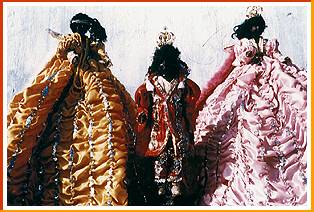

The
calungas, or dolls, of the maracatu
Photo: Pio Figueiroa |
 |
THE
DOLL IS MADE OF WAX
One
of the sacred elements of the Maracatu is the doll, called Calunga,
and also boneca (doll). This element is always
present in the courts of the African Nations, from which originated
our Maracatu. |
Even until today, the
Calunga is part of the Maracatu ritual and, like so many other
sacred objects - axés, embodies the strength of the group's ancestors.
Sacred songs are sung in honor of the Calunga
within the headquarters of the group, at the moment the Calunga is taken down
from the altar by the female dance leader. It is then passed to the hands
of the queen, who then passes it to the nearest baiana2 woman. And thus, it
is passed round from hand to hand, until it returns to the hands of the female
sovereign. In the Elephant Maracatu, in a research carried out
by the musicologist Guerra Peixe, between 1949-1952 , three Calungas featured most heavily:
Emilia, Luis and Leopoldina.
A boneca é de cera The doll
is made of wax
É de cera e madeira Of wax and
wood
A boneca é de
cera The doll is made of wax
É de cera e madeira
Of wax and wood
The most attention was dedicated to the
Calunga - Emilia. The first sacred song, mentioned above, was dedicated to her,
during the ceremony also denominated "the dance of the doll". "The
most powerful sacred songs were also dedicated to her - the most important doll,
which was carried to the door of the church of Our Lady of the Rosary. It is with this
doll that the Elephant Maracatu dances at the entrance of the African
religious centers (centers dedicated to shango - God of lightning
and thunder), which they
visit. It is with these songs, offered to Emilia, that the musicians
execute the rhythm of Luanda - the beat 'to save the dead'
or
eguns". 3
"Luis", according to
Guerra Peixe, represents "an African king" and is consequently
considered the "King of the Congo" by the members of the group.
This is certainly coherent with the recent interpretations of Alberto da Costa e Silva (op.
cit.). He makes a clear reference to the very beginnings of these festivities,
coinciding with the belief that the powers of the Calunga have a direct
link to their African ancestors, as illustrated in the lines of this
hymn: "A bandêra é brasilêra/ Nosso reis veio de Luanda /
Ôi, viva Dona Emília / Princesa Pernambucana"
"The flag
is Brazilian/ Our king comes from Luanda / Long live Emilia / Princess of
Pernambuco".
1 SILVA, Alberto da Costa e. A enxada e a lança
- A África antes dos portugueses. (The spade and the spear -
Africa before the Portuguse) Rio: Nova Fronteira, 1992.
2 Broadly
speaking, it is a woman who originates from the State of Bahia, and is a commonly
used carnival female symbol. These women wear the traditional African
costume still to be found in Salvador,
Bahia.
3GUERRA-PEIXE, César. in Maracatus do Recife. (The Maracatus of
Recife) Prefácio de Leonardo Dantas Silva. Recife: Fundação de Cultura, 1981. 172
p. il.(Coleção Recife, v. 14).

|